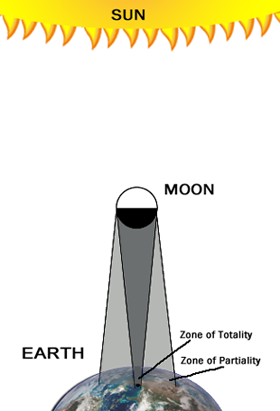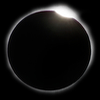
May 2017 - Vol. 21, No. 5
This Month's Night Sky - NOTE: The next paragraph describes the sky as it appears at 10 pm EST (11 pm EDT) near mid- month. The sky also looks this way at 11 pm EST (midnight EDT) during the beginning of the month and at 9 pm EST (10 pm EDT) by month's end.
As May brings the lengthening days, the hours of nightly observation decrease as well, it is always with a bit of sadness that we say good-bye to the Winter and Spring constellations, Gemini, Leo, and Virgo. The early evening presence of Arcturus, the second brightest star in the northern sky, reminds us that the bright star clouds of the Milky Way will soon be brightening up those dark evenings when the Moon is small enough to allow us to truly enjoy those galactic treasures. As the evening turns to morning, the bright stars of the summer triangle follow until just before sunrise, the Milky Way is at the zenith, high overhead. Long twilight hours come to the northern hemisphere.
MERCURY in the morning sky this month, reaching apehion on the 6, and joining the crescent moon on the 24th. This apparition favors southern-based observers.VENUS shines brightly in the morning sky (mag. -4.7). MARS in Taurus will be 6 deg. away from Aldebaran on May 7. How does the color of these two objects compare? JUPITER now past opposition is in the constellation of Virgo and will rule the evening sky this Spring. SATURN moves in to Ophiucus this month, at .2 mag, this planet is unable to compete with Jupiter but still presents a delight view when telecopes reveal its rings. URANUS and NEPTUNE also appear in the morning sky to observers armed with telescopes. It's been quite awhile, but there is no occultation of Aldebaran this month, the last time that occurred was May 2015.
Review how to determine Angular Measurement.
Calendar of Events
NOTE: For those observers not in the ET zone, convert the calendar times to your zone's time by subtracting one hour for CT, two for MT and three for PT. Don't forget to adjust for Daylight Savings Time when necessary by subtracting one hour from your planisphere's time. Dawn and dusk times must also be corrected. See your local newspaper, TV news, or cable TV's Weather Channel for sunrise and sunset times or check with the U.S. Naval observatory. Unfortunately some of these events may occur during daylight hours in your area.
| DATE | EVENT |
| 04 | Moon 0.5 deg S. of Regulus, occultation from Indonesia, Malaysia, s. New Guinea, Australia, and New Zealand. |
| 05 | Eta Aquarid meteor shower, up to 60 per hour may be seen at the zenith from a dark site. Best observing is after midnight, watch for meteors early Friday morning. |
| 07 | Jupiter 2 deg S. of Moon. |
| 12 | Moon at apogee. |
| 13 | Saturn 3 deg S. of Moon. |
| 20 | Neptune 0.5 deg N. of Moon, occultation from Falklands, south Africa, Madagascar, and Maldives. This cannot be observed without a telescope. |
| 22 | Venus 2 deg N. of Moon |
| 22 | Mercury 1.6 deg N. of Moon |
| 26 | Moon at perigee, expect large tides. |
| 31 | Regulus 0.3 deg N. of the Moon occultation from Eastern Brazil, Cape Verde Island, central and south Africa, and Maritius. |
Lunar Almanac for May 2017
| Phases of the Moon | Phase and Date(s) | Best viewed before local midnight |
 |
New 25 |
Deep Space Objects |
 |
1st. Qtr 03 |
Planets & Moon |
 |
Full 11 |
Moon |
 |
Last Qtr 19 |
Deep Space & Planets |
Topic of the month: Total Solar Eclipse August 21, 2017 U.S.A.

By now, many of the citizens of the U.S.A. have learned that a very rare phenomenon is about to grace the shores of the contiguous US states. The event is a total solar eclipse whose umbral path or moon shadow will cross about 3000 miles of the United States. Starting at the west coast, the shadow arrives in the late morning at the Pacific state of Oregon, races across fourteen US states, and plunges into the Atlantic by the southern state of South Carolina in the early afternoon, 4 hours 5 minutes and 47 seconds later. Totality will grace many National Parks and Monuments, various state capitals and major metropolitan areas as well as inaccessible mountain peaks. This is an event that Astra sincerely hopes will be seen by millions of her fellow citizens and visitors. The unbelievably beautiful and exciting total solar eclipse is almost guaranteed to spawn many new, young astronomers, and amateur observers. This eclipse umbral path will cover only landmasses in the continental US. This month's night sky article is about making daytime observations of the August 21, 2017 total solar eclipse.
So what is a total solar eclipse and how does it happen? A total solar eclipse happens during a new moon when the Moon and the Sun are perfectly aligned, darkness comes on Earth where ever the Moon's shadow falls. Have you ever noticed that the disk of the Sun and the Moon appear to be about the same size in the sky? The fact is they are very close. The Earth and the Moon are in orbit around the Sun, in addition the Moon is orbiting the Earth. Orbits are always ellipses, although some may be nearly circular. In an elliptical orbit, there are two points, one at the closest distance and another at the furthest. This means that the disks of the Moon and Sun are slightly larger at the close point (we use the term peri-), and slightly smaller at the far point (we call that ap-). In addition the Moon’s orbit is inclined to the ecliptic by 5 degrees, that is the plane of the Earth’s orbit about the Sun. This means that the Moon moves north and south in relation to the Earth's equator like a yo-yo on a string. Only when the Sun and the Moon are at the same point on the ecliptic (called nodes) can an eclipse occur.
Because all of the orbits are stable, this happens on a regular basis, about every 6 months, that is called an eclipse season. This means that there are approximately 2 eclipse seasons per year. A total solar eclipse occurs when the Moon is closest to the Earth, we use the term perigee. If the Moon is closer to apogee, a different kind of eclipse occurs; that is called an annular eclipse because the Sun appears as a ring and there is no total darkness. Whenever the Moon does not completely cover the disk of the Sun, it is called a partial eclipse. During any total eclipse localities not on the umbral path will see only a partial eclipse.
Darkness comes in daylight when the disk of the Sun is totally obscured, or eclipsed by the Moon. When the Moon's disk first covers the Sun, it is called first contact. As the eclipse progresses, the Earth below becomes cooler and the bright day continues to lose heat and intensity. Second contact comes at the beginning of totality. As the Moon covers the entire Sun, light begins to fade completely, the last point before total obscuration, the famous "Diamond Ring" effect appears, the only remaining spot of the Sun peaking from behind the lunar disk. Soon, only a thin edge of the Sun peaks through the mountainous terrain on the limb of the Moon, creating dots of light called "Baily's Beads".  Second contact heralds totality. The Earth is plunged into darkness, now and only now, observers can stare directly at the disk of the Sun, er, um Moon. The Sun's chromosphere appears red, only briefly, and then the fantastic bellowing corona appears as a massive white mist shooting out from behind the Moon. Temperature of the gasses and ions in this white cloud is well over 1 million degrees. From the surface of the Sun, magenta prominences will spout past the lunar disk clearly visible to a ground-based telescope, now capable of imaging the eclipsed Sun without danger to observers or sensitive equipment. People and animals in the zone of totality become excited or confused. Devoted eclipse chasers give out a shout! All too soon, totality ends and once again eyes and instruments must be protected from the Sun's radiance.
Second contact heralds totality. The Earth is plunged into darkness, now and only now, observers can stare directly at the disk of the Sun, er, um Moon. The Sun's chromosphere appears red, only briefly, and then the fantastic bellowing corona appears as a massive white mist shooting out from behind the Moon. Temperature of the gasses and ions in this white cloud is well over 1 million degrees. From the surface of the Sun, magenta prominences will spout past the lunar disk clearly visible to a ground-based telescope, now capable of imaging the eclipsed Sun without danger to observers or sensitive equipment. People and animals in the zone of totality become excited or confused. Devoted eclipse chasers give out a shout! All too soon, totality ends and once again eyes and instruments must be protected from the Sun's radiance.
OK, this is where Astras must warn folks: Please protect your eyes from exposure to the Sun! Check carefully any filter you use, including the cute cardboard eclipse glasses you just bought for a buck. The Sun can steal your vision, even if your eyes are not pained when you look through the filter. Make sure there are no pinholes. Also, while you are standing out in the summer sun for 2 or 3 hours, wear some sun screen, skin cancer is no joke. And remember: enjoy! enjoy! enjoy!
The August 21, 2017 total solar eclipse U.S.A. is the first total eclipse umbral path to reach any of the contiguous United States since February 26, 1979. The umbral path of that eclipse crossed only states in the northwest region of the country. This eclipse occurred during winter months and was clouded out for many locations. In 1991, the total solar eclipse umbral path crossed over the Pacific Ocean state of Hawaii. For both of these eclipses, sun chasers who were successful were willing to relocate to areas where viewing was possible. This year's eclipse is much more generous, crossing the length of the country. Please DO NOT miss viewing this eclipse if you are anywhere near the umbral path and make plans now to get to the path if you are not. Many eclipse-blessed locations have already filled up lodgings and sold out tickets to related events. For more information on this eclipse, check out Astra's Guide to the August 21, 2017 Total Solar Eclipse on this website.
--See You Under the Stars!
Astra for Astra's Almanac
The images above were created by Dawn Jenkins and are copyrighted. Please contact Astra at astra@astras-stargate.com if you wish to use them (especially the eclipse diagram) in another publication or website. Astra is open to sharing content with astronomical and educational organizations and individuals. The same applies to the text of the total solar eclipse featured article
This installment of "What's Up?" is ©2017 by Dawn Jenkins for Astra's Stargate. View Ron Leeseburg's Farewell Issue for information on where to find information such as is presented in this almanac.